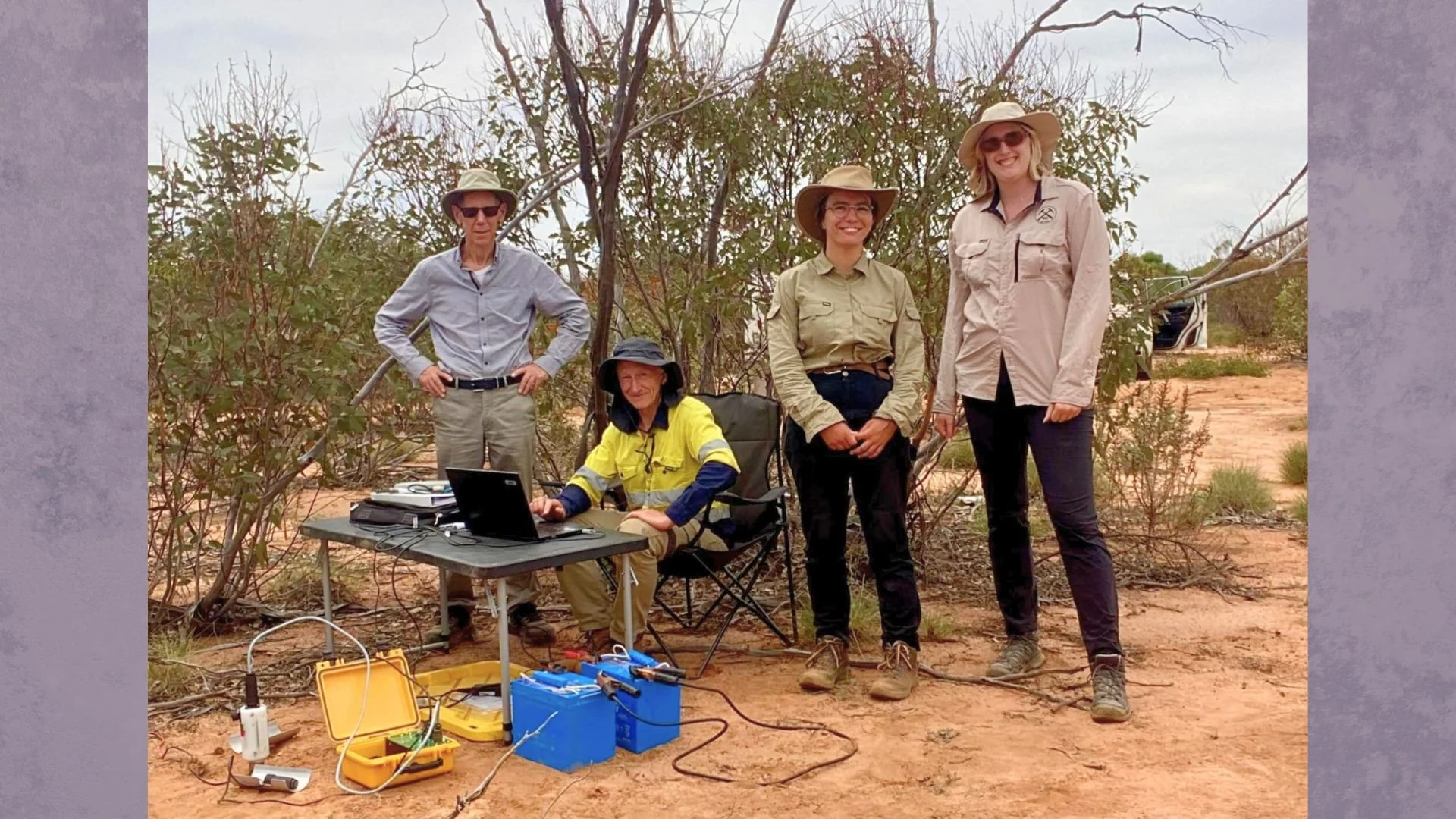In the field with AuScope at TERN’s Critical Zone Observatory
Left to right: David Chittleborough, Graeme Beardsmore, Nicola Lieff and Georgina Virgo observing a thermal conductivity measurement of the soil. Image: Georgina Virgo
Researchers from the University of Melbourne (UoM) and the University of Adelaide (UoA) recently met at the Calperum Critical Zone Observatory on the lands of the Meru People near Renmark (South Australia) to begin an exciting new NCRIS-enabled collaboration. The team are tracking energy and water movement at the atmosphere-to-ground boundary to understand ecosystem health.
In the field
Over the course of three days (19–21 February), AuScope’s Dr Graeme Beardsmore (UoM), along with TERN’s Prof David Chittleborough (UoA), Dr Georgina Virgo and Nicola Lieff from UoA, installed experimental conductive heat flow sensors and collected the first preliminary data for the new program. The team installed three heat flow sensors for this trial, each close to an existing soil moisture sensor. The new sensors will provide insights into heat conduction into and out of the soil and its relationship to evaporation and condensation.
Professor David Chittleborough and Professor Graeme Beardsmore discussing the data. Image: Georgina Virgo
Observing heat over time
TERN Critical Zone Observatories (OzCZO) measure the ebb and flow of energy and water across the atmosphere-to-ground boundary and monitor the impact on the local ecosystem. Existing TERN sensors record incoming radiation from the sun during the daylight hours, and outgoing radiation from the ground surface throughout the day.
In summer, it is usual for incoming radiation to exceed outgoing radiation, with the excess energy warming the ground. Some heat evaporates water in the soil, and some conducts downward into the deeper soil layers. In winter, outgoing radiation generally exceeds incoming, heat in the deeper soil then conducts back out to the surface, and water condenses from the air during chilly nights.
What makes this project unique
TERN previously experimented with conventional ‘heat flux plates’ to measure heat conduction into and out of the soil. But heat flux plates distort the movement of heat around them, providing only an approximate picture of true energy flows. The experimental heat flow sensors installed for this project are designed for minimum impact on true heat flow.
The collaboration between AuScope and TERN draws on the strengths of both NCRIS enabled organisations. AuScope provides cutting-edge research infrastructure for earth sciences and supports the development of unique heat flow sensors with potential applications in other fields as diverse as gold prospecting, Antarctic research, groundwater investigations, and geothermal energy exploration. TERN manages the world-class OzCZO facilities investigating the complex interrelationships of unique Australian ecosystems.
The University of Melbourne, supported by AuScope, and the University of Adelaide, supported by TERN Australia, cross-NCRIS pilot project at Calperum Critical Zone Observatory in South Australia. Image: Graeme Beardsmore
Activities
The new heat flow sensors passively record the temperature at seven depths in the top 110 cm of soil at 15 minute intervals, 24 hours a day. The UoM or UoA researchers will periodically revisit the site to download data and carry out soil thermal conductivity measurements with the sensors. Over time, the data sets, combined with those from other sensors, will provide valuable insights into the water and energy exchanges in the soil and, possibly, a deeper understanding of the background flow of heat from the Earth’s deep interior.
“It is incredibly exciting to apply cutting-edge geophysical technology to deepen our understanding of biological systems. The results from this interdisciplinary collaboration will help to further refine the sensors for applications in other fields.”
– Dr Graeme Beardsmore, Geophysicist, University of Melbourne
Left: Georgina Virg and Nicola Lieff inserting a steel casing. Centre and right: Dr Graeme Beardsmore inserting a high-precision temperature sensor into the instrument casing. Image: David Chittleborough
Key Dates
UoM and UoA are planning a return visit to Calperum in May 2024, when the new sensors will have been recording for three months. With the training of technicians and students, the goal is then for regular visits about once each month. If data quality and research outcomes justify further development, a data telemetry system can be developed for real-time online monitoring of conductive heat flow.
Future Impact
“This instrument deployment and collaboration represents a very important milestone for AuScope and TERN. Dr Beryl Morris, the TERN Director, and I have been working together for a number of years to identify opportunities for the co-deployment of infrastructure at CZO sites around Australia.
This deployment represents the first step towards realising that ambition and we congratulate those involved for making it happen.”
– Dr Tim Rawling, AuScope CEO.
We acknowledge First Nations Peoples as the Traditional Custodians, Lore Keepers and first scientists of this land. We pay our respects to their Elders, past and present, and extend our respect to all First Nations Peoples.
Curious to know more
Discover more Earth Imaging & Sounding activity here.
STORY IN A NUTSHELL
A new NCRIS enabled cross-disciplinary collaboration between AuScope and TERN is applying cutting edge geophysical sensor technology to biological ecosystem research.
AUTHOR
Dr Graeme Beardsmore, University of Melbourne
Edited by Philomena Manifold
TEAM
Dr Graeme Beardsmore (UoM)
Prof David Chittleborough (UoA)
Prof Sally Thompson (UWA)
Dr Juraj Farkas (UoA)
Prof Wayne Meyer (UoA)
FURTHER READING
Australia turns up the heat on heat flow data | AuScope
Critical Zone Observatory project kicks off at Calperum | TERN




